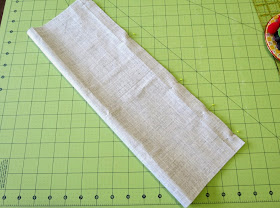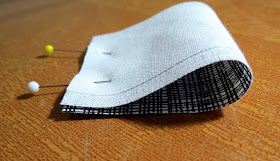So cutting from your fabric as indicated above (the main piece is just to show placement--remember we have that part already), cut out the pieces for the zip pocket and the pleated pocket. We'll start with the zip pocket first to get it out of the way for those of you have some zipper anxiety. Take your lining piece and lay it down face up with the flappy bits extending towards the sides and not out of the top/bottom. Take the zip pocket piece you just cut and lay it down like so:
The ten inch side runs across the top and is centered, while also being lined up with the line of of the flaps. The 14 inch part is the length that will fold up to form our pocket in a few steps.
Draw a line that is 1 1/4 inch down from the top edge of your pocket piece, and that is one inch in from the sides (see my purple line below?)
Draw a matching line 3/8 inch down from the first, and then close off the ends to make a long skinny rectangle.
Divide that rectangle in half lengthwise, and draw in some triangular points about 3/4 inch in from the edges like so:
Pin around your rectangle, and then sew that down. Only sew the outer rectangle--pretend the other lines don't exist.
Now very carefully cut along that center line from triangle point to triangle point, and then from the point towards each corner, getting as close as you can to the corner without cutting your stitches.
Now pull your pocket piece through that slit so it is on the wrong side of your lining piece.
We need to give that a convincing press. If you pick up the top/bottom edges of your pocket piece you'll see some wee seams. Press those open.
Now lay everything back down again, and press along the slit edges nice and neat. Pressing that wee seam open makes this part easier.
See? Nice and neat and flat.
Flip the whole thing over and press again.
Get your shorter zipper, and simply lay the fabric slot down on top of it. Put in a few pins to keep it in place (or fabric glue works just as well if you've got some handy).
I use a standard presser foot for this part. I make sure everything is nice and flat on the underside so nothing gets caught up in my stitching. Then simply sew around the rectangle, securing your zipper in place.
On the wrong side of your lining you'll see your pocket piece is dangling all loosey-goosey with a zipper at the top. Bring the bottom edge up to the top edge and pin in place (this will want to wiggle so definitely pin). Then stitch that edge.
Close up the side seams of the pocket in the same way. Make sure to keep the other bits out from under the needle and just sew the pocket. Trim off any excess zipper tape, and there you go.
Let's do the pleated pocket. This lining fabric doesn't take kindly to showing the marks I make on it, so I'm going to be using pins instead of a marker. The pictures are cuter anyway :)
So take that pleated pocket piece, and fold it in half, longer edges together, and stitch, forming a tube.
Press that seam open lightly so you don't crease the rest of the fabric, turn the tube inside out, and press again. The edge where the seam is will be our top pocket edge, so add a few rows of top-stitching along the edge to secure the seam, and because top-stitching is cute. Now we need to make the markings for our pleats.
Make a mark 5 inches in from each edge (my yellow pin in the photo). You could also go in up to 6 inches from the edge, but I wouldn't do more than that. Five inches gives you a larger center pocket, and up to six will give you three more evenly sized pockets, so decide on your preference. Once you place those pins (two pleats, remember, so do this from each edge), place pins one inch away on each side from both of those original pins.
We'll start with the pleat on the left. Pick up the left edge of your tube, and fold it over so that the two red pins end up on top of each other, and the yellow pin is in the fold.
Pin through all the layers where the red pins meet (I used a yellow pin). I took this photo when doing the other edge, so that's why my fabric is flipped here.
Now, you're going to flatten out that little fold so that the yellow pins are on top of each other. Pin the bits in place on both sides.
Repeat for the other pleat. Neatly arrange your pleat (your fabric will cooperate nicely here) and lightly press it.
This piece should be 13 inches wide. You may need to trim a wee bit off the edges, as sometimes things wiggle around when sewing pleats, so you can either do that now or after the next few steps.
We're going to sew this pocket down and then flip it up, so placement is very important so you don't end up with a pocket that faces the bottom of your bag. Get your exterior piece and your pockets. I'm calling the side of the pocket that has all the folds showing the wrong side. You're going to place this wrong side up with the bottom edge of the pocket 1/2 inch from the bottom flap, and the rest of the pocket laying across that bottom flap. The pictures make this clearer.
Pin that down, and then sew close to the bottom edge that you've pinned in place (no more than 1/4 inch). Flip your pocket up and press that seam flat. Then top-stitch close to the pocket edge to make it more secure.
You could technically lay your pocket down and just stitch the bottom side and be done with it, but this way makes me feel more secure that my pleats are being held in place by two lines of stitching. Now, manipulate the fabric like the above so that the pleats are reasonably flat near the top. See that line between the pleats?
That's going to be our guideline for dividing our pockets. Following that line, draw a line to stitch along:
Then, working from the bottom edge towards the top edge, sew along that line. At the top edge I go over the stitches several times as that's a high stress area that benefits from a few extra stitches holding it all in place.
And bam. Cute pleated pockets.
Now your lining should look like this (don't fret--I pressed it after I took this photo):
Let's do one more thing before we set it all aside for the day. You should have a few little bits of fusible interfacing remaining as well as some fabric from all parts of this bag. We're going to make the tabs for the zipper, so decide which fabric you want to use for that. Cut two pieces that are each 2 inches by 4 inches and two pieces of interfacing that are 1 1/2 inches by 4 inches. Fuse the interfacing straight down the center of the wrong side of the fabric.
With right sides together, fold the fabric so the short edges match and stitch 1/4 inch in from the edge (you should be stitching right next to the interfacing).
Trim the corners, but don't get too close to your stitching.
Turn these little bits inside out, gently poke out the corners (don't bust through your stitching), and press. You can add some top-stitching if you'd like but it's not necessary. I didn't because you wouldn't be able to tell on this fabric anyway, but if I was using something plainer I probably would.
At this point, you should have your exterior piece with the handles attached, the lining with two different pockets, your zipper tabs, and one remaining zipper.
Come back on Friday and we'll organize all this nonsense into a bag!





































No comments:
Post a Comment